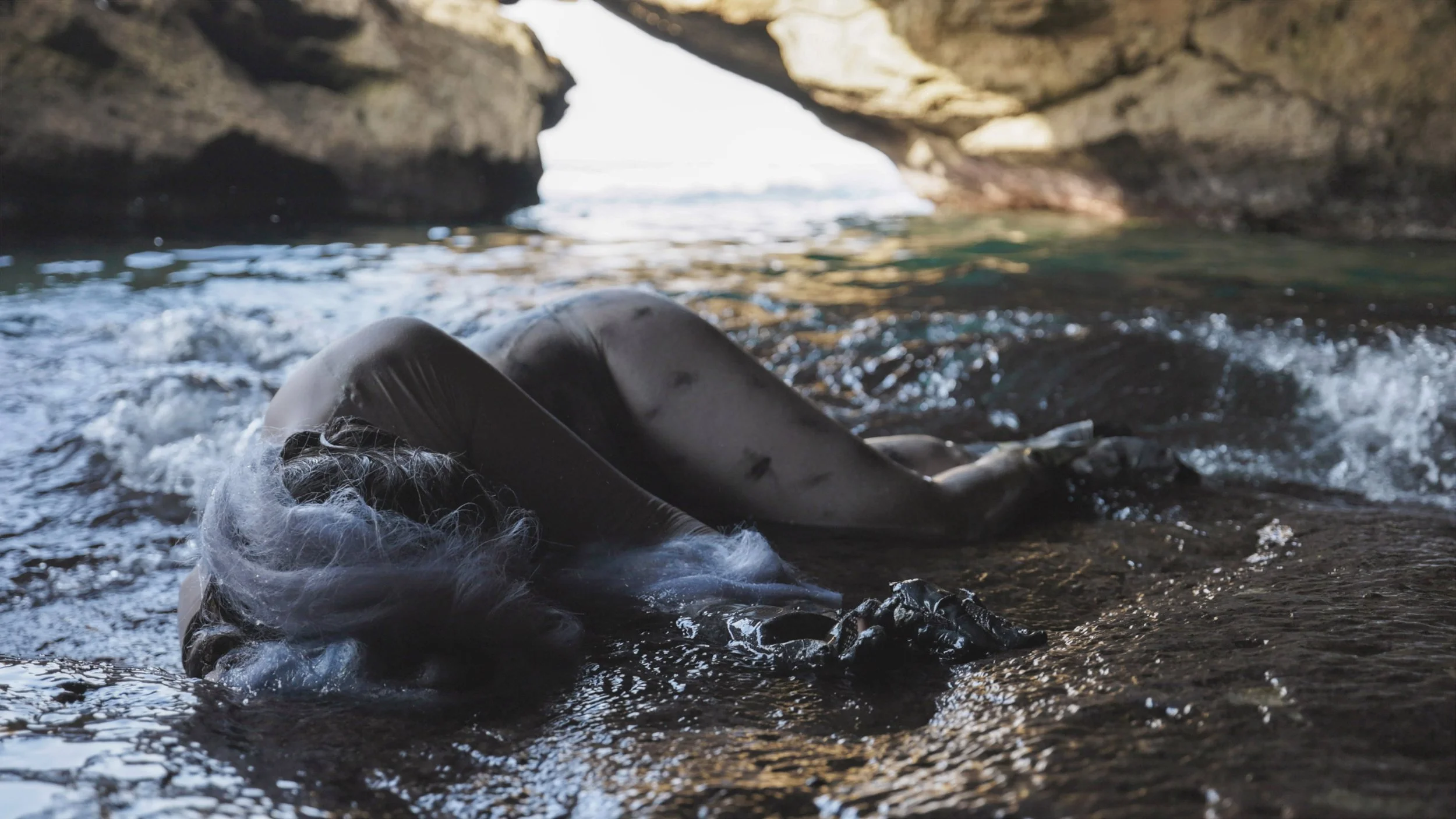Ground Water
A solo exhibition by Talya Raz
Curator: Lior Schur
18.10.2025 - 22.11.2025
The exhibition Ground Water by artist Talya Raz invites viewers to dive into mythical, psychological, and personal depths. This is the final chapter in a trilogy of multidisciplinary installations, each unfolding as a self-contained world: from the enchanted forest of The Wild Swans (Alfred Gallery, 2020), through the shadowy cave of Take Me (Lohamei HaGeta'ot Gallery, 2021), to the underwater journey of Ground Water.
On the shores of the northern sea, where the waves whisper secrets older than time, lived the Selkies. By day they were seals, but on moonlit nights they could shed their skin and walk the land as humans.
There is a tale told of a fisherman who found the skin of a female seal. He hid it, thus forcing the Selkie—whose skin it was—to remain with him. For many years she lived by his side, bore children, and though part of her heart grew attached to the land, the ocean within her never stilled.
When she finally found what had been stolen from her, she knew how painful the choice would be: to stay with her loved ones, or to return to her origins and reclaim the self she had lost. Finding courage, she donned her skin and returned to the sea.
It is said that on stormy nights, she can be seen from afar on a rock, her gaze filled with longing—for the land she left and for the waves.
The exhibition’s point of departure is the figure of the Selkie, drawn from Celtic folklore—exquisite hybrid creatures capable of shapeshifting between worlds, shedding their animal skin and taking on human form. The legend of the Selkie whose skin was stolen, trapping her between sea and land, echoes questions of identity and belonging, of lost freedom and the imposition of social norms. For Raz, the Selkie provides the impetus for a broader exploration of gender boundaries, family, sexuality, and transitional states of constant transformation.
The works in the exhibition construct a space charged with tension: the gallery’s stage functions as a simulated aquarium—a watery environment that is vibrant and teeming, yet sealed and opaque. The video, filmed underwater, is rich in both physical and metaphorical depths, from which the Selkie emerges like a messenger—evoking desire, while also reminding us of the unconscious’s power to pull us in and reclaim us.
Raz’s delicate watercolor paintings depict, again and again, heads of women, girls, and seals, conveying multilayered encoded meaning. White hybrid sculptures, cast in plaster, fuse body parts with seashells. Across the gallery floor, head sculptures are arranged to suggest stages of drowning or surfacing from underwater. All of the works position the body and its image in a state of tension—between submersion and disappearance— or rebirth and transformation.
In the spirit of Carl Gustav Jung, who discussed archetypes of the collective unconscious, the Selkie can be seen as an archetype akin to the mermaid—her uniqueness lies in the tension between domestication and yearning for the wild. For Jung, this represents meeting of the Shadow (the rejected) and the conscious Self. The Selkie embodies the figure of the “Other”: hidden, animalistic, and often repressed. She emerges from the depths as a threatening force, but also as a potential source of freedom and transformation.
Raz’s Selkie evokes reflections on yearning for authentic essence. The stories in which the Selkie is taken captive but ultimately returns to the ocean embody the inner drive to reconnect with the “Self” and resist external impositions. This is a realization of “the Other”: a woman-animal who refuses to conform to a clear demarcation between the human (cultural) and the natural, thereby exposing such boundaries of identity as fragile, porous, and fluid. The myth and the archetypes it draws upon serve, for Raz, as gateways into exploring the underlying fears, desires, and yearnings that propel her.
Talya Raz converses with a lineage of women artists who have explored the relationship between body, material, and intersections of feminine identity. From Louise Bourgeois, who illuminated the complexities of the maternal experience, through Rebecca Horn, who used performance and prosthetics to emphasize the body’s boundaries and the possibility of stretching them, to Ana Mendieta, who used her own body as a central element through performances and physical gestures created in situ, merging intimately with the elements of nature. Raz positions herself within a critical feminist tradition that frames the body and its functions as a site of rupture and reinvention.
Ground Water offers a multilayered experience—visually, emotionally, and cognitively. It juxtaposes a sense of danger and being on the edge of an abyss with the possibility of rebirth, hovering between a vulnerable body and a powerful mythical image. Like groundwater that flows in the depths, undetected from above, Raz’s works offer a glimpse into the hidden currents from which we draw our existence, such that enable seeking and articulating a wide open and evolving mode of being.
About the artist and the curator
Talya Raz is an artist and a member of the Alfred Cooperative Institute for Art (since 2012). She holds both a BA and an MFA in Fine Arts from the University of Haifa (2007), and studied at the Free Academy of Visual Arts in The Hague, Netherlands (2000).
Raz has participated in residency programs and has exhibited in solo and group exhibitions in Israel and abroad, including: the Haifa Museum of Art; the Municipal Gallery in Bremen, Germany; Gallery 39, Tel Aviv; Beton Box Gallery, Düsseldorf, Germany; the Lohamei HaGeta'ot Gallery; and Hanina Gallery, Tel Aviv.
Lior Schur is a visual artist and a member and curator at the Alfred Cooperative Art Institute (since 2013). She holds a B.ed in Art and Education from the excellence program at HaMidrasha Faculty of Arts, Beit Berel (2008) and is a certified Art Therapist (MA) from Lesley University (2014). Co-founder of the "Art Animals" project: Art viewing courses that combine visual and verbal texts.








